You are using an out of date browser. It may not display this or other websites correctly.
You should upgrade or use an alternative browser.
You should upgrade or use an alternative browser.
Export thread
Murry lawn tractor Model 40604B
#1
H
Harold2689
H
Harold2689
Hello!
I have a Murry lawn tractor, Model 40604B, manufactured: 0272. It has a 12HP Briggs & Stratton engine. It was running perfectly, when suddenly it started running very rough, and at the same time, started blowing blue smoke out of the muffler. I removed the "hood" and shroud of the mower to gain access to the engine, and found the spark plug and the muffler both LOOSE. I also removed the upper air cooling housing from the engine, and found the cooling fins around the cylinder, and the area around the head, packed with mice nesting material! After cleaning all that out, I noticed that the bottom third of the head seemed to be "wet" with oil. After changing the spark plug, and tightening the muffler, the engine started up, ran for about 30 seconds, billowing blue smoke all the time, and gradually running rougher and rougher until it died again. I removed the cover over the valve springs, and "thin" oil poured out. By thin, I mean gasoline mixed with crankcase oil.
I'm thinking possibly a blown head gasket? What say you guys? I cannot locate a manual for either the engine or the mower.
Thanks in advance for any light you can shine on my problem, and any help or suggestions you may be able to offer.
Harold
I have a Murry lawn tractor, Model 40604B, manufactured: 0272. It has a 12HP Briggs & Stratton engine. It was running perfectly, when suddenly it started running very rough, and at the same time, started blowing blue smoke out of the muffler. I removed the "hood" and shroud of the mower to gain access to the engine, and found the spark plug and the muffler both LOOSE. I also removed the upper air cooling housing from the engine, and found the cooling fins around the cylinder, and the area around the head, packed with mice nesting material! After cleaning all that out, I noticed that the bottom third of the head seemed to be "wet" with oil. After changing the spark plug, and tightening the muffler, the engine started up, ran for about 30 seconds, billowing blue smoke all the time, and gradually running rougher and rougher until it died again. I removed the cover over the valve springs, and "thin" oil poured out. By thin, I mean gasoline mixed with crankcase oil.
I'm thinking possibly a blown head gasket? What say you guys? I cannot locate a manual for either the engine or the mower.
Thanks in advance for any light you can shine on my problem, and any help or suggestions you may be able to offer.
Harold
#2
R
Rivets
R
Rivets
Sounds like you have more than one problem. From what you posted you have a blown head gasket and the float needle is not seating properly, allowing raw fuel to run into the crankcase. Please post you engine model, type and code numbers and I should be able to provide you with a service manual. Also include the name on the engine ie, Vanguaard, Intec, I/C.
#3
H
Harold2689
I wish I had that info. All I have is that the engine is Briggs & Stratton. It's marked 12 HP on the lawn tractor, not the engine. It's a single cylinder, vert shaft, electric start engine. That's all the technical specs I have right now, and that's not much to go on. I'm sure there's a plate somewhere on the engine, but I haven't found it yet. It was my mom & dad's, and I inherited it when Mom passed several years ago. They bought it used, and it ran perfectly until the last time I used it.
I was thinking head gasket, but I wanted input from you guys. It's not at my house, so I'll have to see if I can locate more info on the engine next time I go over there.
Thanks so much for your input.
Harold
H
Harold2689
Sounds like you have more than one problem. From what you posted you have a blown head gasket and the float needle is not seating properly, allowing raw fuel to run into the crankcase. Please post you engine model, type and code numbers and I should be able to provide you with a service manual. Also include the name on the engine ie, Vanguaard, Intec, I/C.
I wish I had that info. All I have is that the engine is Briggs & Stratton. It's marked 12 HP on the lawn tractor, not the engine. It's a single cylinder, vert shaft, electric start engine. That's all the technical specs I have right now, and that's not much to go on. I'm sure there's a plate somewhere on the engine, but I haven't found it yet. It was my mom & dad's, and I inherited it when Mom passed several years ago. They bought it used, and it ran perfectly until the last time I used it.
I was thinking head gasket, but I wanted input from you guys. It's not at my house, so I'll have to see if I can locate more info on the engine next time I go over there.
Thanks so much for your input.
Harold
#4
R
Rivets
R
Rivets
The engine numbers are stamped on the shroud, either on top by the spark plug or on the side.
#5
H
Harold2689
yeah, They're usually on a tag, but I didn't see them when I looked. I'll swing by tomorrow and have another look...
H
Harold2689
The engine numbers are stamped on the shroud, either on top by the spark plug or on the side.
yeah, They're usually on a tag, but I didn't see them when I looked. I'll swing by tomorrow and have another look...
#6
H
Harold2689
Ok, I stopped by today and discovered why I didn't see the numbers before.
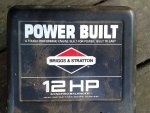
Here's the engine cooling shroud. I was looking for an aluminum tag riveted to it.
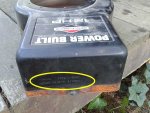
They were actually stamped into it...

THAT'S what I was looking for...
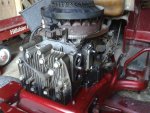
See the bottom quarter of the head is black? It's oil residue.
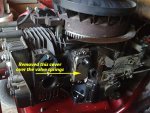
When I removed the cover over the valve springs, oil thinned with gas poured out.
I'm pretty convinced the head gasket is blown, and I'll start with that. I need to get a complete gasket kit, and we'll see if there is still a leaking gas problem. There wasn't until the head gasket blew, so I don't know if there are two separate problems, or just the one.
Any info you can provide will be greatly appreciated. Now that I have the model number, I'll see what I can find on line.
Thanks again,
Harold
H
Harold2689
The engine numbers are stamped on the shroud, either on top by the spark plug or on the side.
Ok, I stopped by today and discovered why I didn't see the numbers before.

Here's the engine cooling shroud. I was looking for an aluminum tag riveted to it.

They were actually stamped into it...
THAT'S what I was looking for...

See the bottom quarter of the head is black? It's oil residue.

When I removed the cover over the valve springs, oil thinned with gas poured out.
I'm pretty convinced the head gasket is blown, and I'll start with that. I need to get a complete gasket kit, and we'll see if there is still a leaking gas problem. There wasn't until the head gasket blew, so I don't know if there are two separate problems, or just the one.
Any info you can provide will be greatly appreciated. Now that I have the model number, I'll see what I can find on line.
Thanks again,
Harold
#7
R
Rivets
R
Rivets
Stop, I DOUBT THE HEAD GASKET IS BLOWN!! The number of times I've seen a blown head gasket on that engine you can count on one hand. You are going to have to do a little more investigating. I'm leaning toward a bad sump gasket or seal around the dipstick tube. Clean and dry the block around the base very good and then coat the entire base area, where the crankcase and sump meet, with baby powder. Spray or puff it all around, light coat. Let it sit for a day and then check for leaks. The powder will tell you where the leak is. To check the seal on the dipstick tube, check to see if you have oil there and it is loose. Don't purchase anything until you know where the leak is, as you may be wasting money. Just my opinion. This manual might be of some help.
https://drive.google.com/file/d/0B6NaqjIxWV1ycG8wd0s3Z2Q2X00/view?usp=drive_web
https://drive.google.com/file/d/0B6NaqjIxWV1ycG8wd0s3Z2Q2X00/view?usp=drive_web
#8
H
Harold2689
Wow! I was all set to go for the head gasket! Would a sump gasket cause the same symptoms as a blown head gasket? I'd have thought if that gasket was a problem, it would just allow crankcase oil to spew oil all over the place, but wouldn't cause the engine to billow blue smoke. Somehow, I think engine oil is getting into the combustion chamber, and from the amount of smoke, I'd say quite a bit. The engine was running just fine when this happened quite suddenly, as if something actually failed. The spark plug, when I removed it, was actually loose, and the business end was wet, and fouled with oil.
I don't have any specialized tools to do some of these tests or replace some of the parts, except for a torque wrench to torque the head bolts. I don't have the leak-down tester, but do have air compressor. I wonder if I could find the leak by just pressurizing the combustion chamber via the spark plug hole and listening/observing for leaks.
Thanks for the link to the manual. It's a LOT more info on this engine than I had.
This may turn out to be a bigger project than I first thought...
H
Harold2689
Stop, I DOUBT THE HEAD GASKET IS BLOWN!! The number of times I've seen a blown head gasket on that engine you can count on one hand. You are going to have to do a little more investigating. I'm leaning toward a bad sump gasket or seal around the dipstick tube. Clean and dry the block around the base very good and then coat the entire base area, where the crankcase and sump meet, with baby powder. Spray or puff it all around, light coat. Let it sit for a day and then check for leaks. The powder will tell you where the leak is. To check the seal on the dipstick tube, check to see if you have oil there and it is loose. Don't purchase anything until you know where the leak is, as you may be wasting money. Just my opinion. This manual might be of some help.
https://drive.google.com/file/d/0B6NaqjIxWV1ycG8wd0s3Z2Q2X00/view?usp=drive_web
Wow! I was all set to go for the head gasket! Would a sump gasket cause the same symptoms as a blown head gasket? I'd have thought if that gasket was a problem, it would just allow crankcase oil to spew oil all over the place, but wouldn't cause the engine to billow blue smoke. Somehow, I think engine oil is getting into the combustion chamber, and from the amount of smoke, I'd say quite a bit. The engine was running just fine when this happened quite suddenly, as if something actually failed. The spark plug, when I removed it, was actually loose, and the business end was wet, and fouled with oil.
I don't have any specialized tools to do some of these tests or replace some of the parts, except for a torque wrench to torque the head bolts. I don't have the leak-down tester, but do have air compressor. I wonder if I could find the leak by just pressurizing the combustion chamber via the spark plug hole and listening/observing for leaks.
Thanks for the link to the manual. It's a LOT more info on this engine than I had.
This may turn out to be a bigger project than I first thought...
#9
R
Rivets
R
Rivets
Remember I said you may have a couple of problems, well I was wrong. I think you only have one problem, that is a bad carb float needle and seat. It will explain all your symptoms. When the needle stop sealing off the flow of fuel into the float bowl, the engine started running rich. Stumbling, smoking, and getting so rich it killed the engine. All the while you were tightening the plug, muffler and cleaning the fins, raw fuel kept running through the carb into the crankcase, thinning the oil. When you started it up again the breather sucked up the misty mixture and pumped it into the cylinder, giving the smoking situation to start again. That being said I would suggest you have the carb cleaned and rebuilt, changing the oil and filter while it is being done. Clean the cooling fins, which was probably the cause of the plug and muffler coming loose, reassemble everything. That should solve your problem. If this unit came into the shop with these symptoms, that is what we would do. That carb is not one I would recommend an amateur try to rebuild. Just my opinion which some members think is to expensive and you should just put a band aid on it, by installinga shut valve in the fuel line. Your choice.
#10
H
Harold2689
Ok, I'll look more at the carburetor. What you say makes sense, and does provide an answer as to why the oil is diluted with gas. I'll start by taking the bowl off of the carb and check the float to see if it cuts off the fuel flow. There is a manual fuel shutoff valve and an in-line fuel filter between the fuel tank and the carb, but I never use it to shut off the fuel flow.
This problem seems a lot simpler than the head gasket, etc., and if it is the problem, I'll leave well enough alone, and won't take the head off at all. I will need to buy or make a few gaskets to replace those for the intake, exhaust, and the one for the breather cover over the valve springs. It will be a few days until I can get back there to work on it, but I will definitely keep this thread updated.
Thanks so much for all of your help and advise.
H
Harold2689
Remember I said you may have a couple of problems, well I was wrong. I think you only have one problem, that is a bad carb float needle and seat. It will explain all your symptoms. When the needle stop sealing off the flow of fuel into the float bowl, the engine started running rich. Stumbling, smoking, and getting so rich it killed the engine. All the while you were tightening the plug, muffler and cleaning the fins, raw fuel kept running through the carb into the crankcase, thinning the oil. When you started it up again the breather sucked up the misty mixture and pumped it into the cylinder, giving the smoking situation to start again. That being said I would suggest you have the carb cleaned and rebuilt, changing the oil and filter while it is being done. Clean the cooling fins, which was probably the cause of the plug and muffler coming loose, reassemble everything. That should solve your problem. If this unit came into the shop with these symptoms, that is what we would do. That carb is not one I would recommend an amateur try to rebuild. Just my opinion which some members think is to expensive and you should just put a band aid on it, by installinga shut valve in the fuel line. Your choice.
Ok, I'll look more at the carburetor. What you say makes sense, and does provide an answer as to why the oil is diluted with gas. I'll start by taking the bowl off of the carb and check the float to see if it cuts off the fuel flow. There is a manual fuel shutoff valve and an in-line fuel filter between the fuel tank and the carb, but I never use it to shut off the fuel flow.
This problem seems a lot simpler than the head gasket, etc., and if it is the problem, I'll leave well enough alone, and won't take the head off at all. I will need to buy or make a few gaskets to replace those for the intake, exhaust, and the one for the breather cover over the valve springs. It will be a few days until I can get back there to work on it, but I will definitely keep this thread updated.
Thanks so much for all of your help and advise.
#11
R
Rivets
R
Rivets
Please just buy the gaskets you need. Yes, I know it will cost a bit more, but if the problem would not bet solved we will know that it is not from trying to save a buck or two. Those who say cardboard will work just fine can start hating me now, but you have to go to the back of a very long line.
#12
H
Harold2689
Ok, I removed the carburetor last week, and finally got to it today. When I removed the bowl, everything looked ok. I blew in the fuel line and manually raised & lowered the float, and it did cut off my air flow. I put it all back together, and cleaned everything as best I could. I made new gaskets (I picked up a small amount of material from the local garage who does all our auto work) and put everything back together. I think you were dead on the money with the float shutoff sticking open. When I opened the drain plug to drain the oil out of the crankcase, BLACK GASOLINE poured out! It had the viscosity of gas, it smelled like gas, but it was black from having diluted all the oil in the crankcase. It is supposed to hold a quart of oil, but I drained almost 2 quarts of gas out of the crankcase. THAT'S why it wouldn't run! I'm guessing that every time the piston want down to the bottom of its stroke, gas-diluted oil was blowing by the rings, and the valve guides, and flooding the cylinder. With the spark plug loose, much of it was blowing out the spark plug hole and the exhaust. Thus all the smoke, and not being able to run.
After I had everything put back together, I refilled the crankcase with 10W-30 synthetic oil, put in a new spark plug, opened the manual fuel shutoff valve, and hit the starter. I'll bet it didn't make two revolutions, and it fired off! I didn't have the top blower shroud on yet because I just wanted to see if it would run. It ran fine, and started to burn residual oil off the muffler, but NO smoke was coming out the exhaust!
I shut it down and completed the reassembly of all the cooling shrouds, and fired it up again. I let it run for several minutes at high speed, with no load, and it ran quite well, with one misfire about every ten seconds or so. After it warmed up, I drove it out of the garage, engaged the blade, and actually cut a little grass. Under load of the blades and moving forward, it never missed a single time. It appears to be running as good as ever now. When I brought it back into the garage, I shut off the manual fuel shut off, and let it run out of gas.
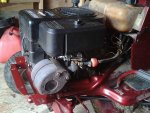
All back together...
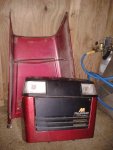
Now, the only thing left is to reinstall the front grill and hood.
I want to thank you so much for your help. It really made this repair a lot easier, and it is greatly appreciated.
Harold
.
H
Harold2689
Ok, I'll look more at the carburetor. What you say makes sense, and does provide an answer as to why the oil is diluted with gas. I'll start by taking the bowl off of the carb and check the float to see if it cuts off the fuel flow. There is a manual fuel shutoff valve and an in-line fuel filter between the fuel tank and the carb, but I never use it to shut off the fuel flow.
This problem seems a lot simpler than the head gasket, etc., and if it is the problem, I'll leave well enough alone, and won't take the head off at all. I will need to buy or make a few gaskets to replace those for the intake, exhaust, and the one for the breather cover over the valve springs. It will be a few days until I can get back there to work on it, but I will definitely keep this thread updated.
Thanks so much for all of your help and advise.
Ok, I removed the carburetor last week, and finally got to it today. When I removed the bowl, everything looked ok. I blew in the fuel line and manually raised & lowered the float, and it did cut off my air flow. I put it all back together, and cleaned everything as best I could. I made new gaskets (I picked up a small amount of material from the local garage who does all our auto work) and put everything back together. I think you were dead on the money with the float shutoff sticking open. When I opened the drain plug to drain the oil out of the crankcase, BLACK GASOLINE poured out! It had the viscosity of gas, it smelled like gas, but it was black from having diluted all the oil in the crankcase. It is supposed to hold a quart of oil, but I drained almost 2 quarts of gas out of the crankcase. THAT'S why it wouldn't run! I'm guessing that every time the piston want down to the bottom of its stroke, gas-diluted oil was blowing by the rings, and the valve guides, and flooding the cylinder. With the spark plug loose, much of it was blowing out the spark plug hole and the exhaust. Thus all the smoke, and not being able to run.
After I had everything put back together, I refilled the crankcase with 10W-30 synthetic oil, put in a new spark plug, opened the manual fuel shutoff valve, and hit the starter. I'll bet it didn't make two revolutions, and it fired off! I didn't have the top blower shroud on yet because I just wanted to see if it would run. It ran fine, and started to burn residual oil off the muffler, but NO smoke was coming out the exhaust!
I shut it down and completed the reassembly of all the cooling shrouds, and fired it up again. I let it run for several minutes at high speed, with no load, and it ran quite well, with one misfire about every ten seconds or so. After it warmed up, I drove it out of the garage, engaged the blade, and actually cut a little grass. Under load of the blades and moving forward, it never missed a single time. It appears to be running as good as ever now. When I brought it back into the garage, I shut off the manual fuel shut off, and let it run out of gas.

All back together...

Now, the only thing left is to reinstall the front grill and hood.
I want to thank you so much for your help. It really made this repair a lot easier, and it is greatly appreciated.
Harold
.
#13
H
Harold2689

H
Harold2689
Today I put the rest of the "pretty stuff" back together. Reinstalled the front grill & the hood. It fired right up and I actually cut the grass with it. It ran great! Before all this happened, I usually ran the throttle about half way to get a comfortable engine rpm and forward speed in 4[SUP]th[/SUP] gear. Today, I barely had the throttle at one-quarter. It is running strong and smooth...
This thing was made in 0272, so it's 44 years old!

It's actually running here, no smoke, and it's purring... 44 years old! Imagine what it'd look like if I washed and "polished" it!
Thanks again for your help!
Harold
This thing was made in 0272, so it's 44 years old!
It's actually running here, no smoke, and it's purring... 44 years old! Imagine what it'd look like if I washed and "polished" it!
Thanks again for your help!
Harold
Attachments
#15

BlazNT
Your mower is a 1990 with that date code. I would need to see the sticker to know for sure. This is a 32 year old murray. Born in 1984.
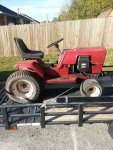
BlazNT
Today I put the rest of the "pretty stuff" back together. Reinstalled the front grill & the hood. It fired right up and I actually cut the grass with it. It ran great! Before all this happened, I usually ran the throttle about half way to get a comfortable engine rpm and forward speed in 4[SUP]th[/SUP] gear. Today, I barely had the throttle at one-quarter. It is running strong and smooth...
This thing was made in 0272, so it's 44 years old!

It's actually running here, no smoke, and it's purring... 44 years old! Imagine what it'd look like if I washed and "polished" it!
Thanks again for your help!
Harold
Your mower is a 1990 with that date code. I would need to see the sticker to know for sure. This is a 32 year old murray. Born in 1984.

#16
B
bertsmobile1
B
bertsmobile1
Nice to hear you have it up and running.
However your method of use concerns me.
Mowers should always be used at full revs ( ~ 3600 rpm)
Working at lower speeds can and does damage the engine and is not helpful to the rest of the mower either.
You have a speed controller to vary your ground speed.
However your method of use concerns me.
Mowers should always be used at full revs ( ~ 3600 rpm)
Working at lower speeds can and does damage the engine and is not helpful to the rest of the mower either.
You have a speed controller to vary your ground speed.
#17
H
Harold2689

I assumed it was manufactured in February of 1972. In any event, It's still in pretty good shape for being 32 years old... :thumbsup:
H
Harold2689
Your mower is a 1990 with that date code. I would need to see the sticker to know for sure. This is a 32 year old murray. Born in 1984.
View attachment 30034

I assumed it was manufactured in February of 1972. In any event, It's still in pretty good shape for being 32 years old... :thumbsup:
#18
H
Harold2689
All my life (and I'm now 70) my dad always chastised me for running any lawn mower or small engine, "wide open." I guess as I grew older, I outgrew the desire to always have an engine running so fast, and now, "slow and easy" still gets the job done. Apparently it hasn't hurt this 32 year old engine and tractor running it that way, as the only problem I had here, after 32 years use, was a one-time, stuck open float valve in the carburetor.
I currently drive a 2000 Ford Ranger truck with 192, almost 193,000 miles on it, still with the original clutch and original disc brake pads. My last vehicle was a 1986 Ford Taurus MT-5 (manual transmission 5-speed). When I got rid of it, it had 211,000 miles on it, also with the original clutch. I did, however, change brake pads on it a few times though...
At my age, I've slowed down, and I believe I'll keep running my mowers and vehicles "slow and easy" too. It's been getting the job done for 32 years so far, and as long as I can keep it running, I'll continue down that same road...
H
Harold2689
Nice to hear you have it up and running.
However your method of use concerns me.
Mowers should always be used at full revs ( ~ 3600 rpm)
Working at lower speeds can and does damage the engine and is not helpful to the rest of the mower either.
You have a speed controller to vary your ground speed.
All my life (and I'm now 70) my dad always chastised me for running any lawn mower or small engine, "wide open." I guess as I grew older, I outgrew the desire to always have an engine running so fast, and now, "slow and easy" still gets the job done. Apparently it hasn't hurt this 32 year old engine and tractor running it that way, as the only problem I had here, after 32 years use, was a one-time, stuck open float valve in the carburetor.
I currently drive a 2000 Ford Ranger truck with 192, almost 193,000 miles on it, still with the original clutch and original disc brake pads. My last vehicle was a 1986 Ford Taurus MT-5 (manual transmission 5-speed). When I got rid of it, it had 211,000 miles on it, also with the original clutch. I did, however, change brake pads on it a few times though...
At my age, I've slowed down, and I believe I'll keep running my mowers and vehicles "slow and easy" too. It's been getting the job done for 32 years so far, and as long as I can keep it running, I'll continue down that same road...
#19
B
bertsmobile1
B
bertsmobile1
A govened engine runs at the speed that the govenor is set for.
A direct throttle engine is a different matter as you can over rev it.
It is not just the engine, the blades are designed to work at a specific speed, bearings are designed to run at specific speeds to get the desired up draft and clean cut.
If you are happy then it is your mower and you are entitled to do with it as you wish.
OTOH this is a public forum so it is important that correct information is presented.
I currently run a 1981 L300 that had done 1,360,000 km and is still on std bore although it has been reringed twice and had 2 sets of big ends.
Neither of the bearing changes were necessary but they come as a kit complete with pistons .
However it is warter cooled and mower engines are mostly air cooled.
Older engines were over cooled , you could run them forever with 2" of mud packed around the cylinder & head but newer ones will cook at the drop of a hat and the slower the engine runs, the worse it cools.
Also the slower the engine runs the less the alternator output is and in some of my customers case, they had been replacing batteries every year or two for this reason.
A direct throttle engine is a different matter as you can over rev it.
It is not just the engine, the blades are designed to work at a specific speed, bearings are designed to run at specific speeds to get the desired up draft and clean cut.
If you are happy then it is your mower and you are entitled to do with it as you wish.
OTOH this is a public forum so it is important that correct information is presented.
I currently run a 1981 L300 that had done 1,360,000 km and is still on std bore although it has been reringed twice and had 2 sets of big ends.
Neither of the bearing changes were necessary but they come as a kit complete with pistons .
However it is warter cooled and mower engines are mostly air cooled.
Older engines were over cooled , you could run them forever with 2" of mud packed around the cylinder & head but newer ones will cook at the drop of a hat and the slower the engine runs, the worse it cools.
Also the slower the engine runs the less the alternator output is and in some of my customers case, they had been replacing batteries every year or two for this reason.
#20

BlazNT
Murray used the code differently. 2 is the year in this case 1992 and 27 is the day of the year. So it was born on January 27, 1992
The date code for the 90"s and newer is DDDY
Model number explained for this and newer years is first 2 numbers is deck size. Next 4 is model number. Anything after that and it is a code for who it was manufactured for.
BlazNT
View attachment 30035
I assumed it was manufactured in February of 1972. In any event, It's still in pretty good shape for being 32 years old... :thumbsup:
Murray used the code differently. 2 is the year in this case 1992 and 27 is the day of the year. So it was born on January 27, 1992
The date code for the 90"s and newer is DDDY
Model number explained for this and newer years is first 2 numbers is deck size. Next 4 is model number. Anything after that and it is a code for who it was manufactured for.
#21
H
Harold2689
I hadn't thought of all that, but it does make sense. I've never measured rpm, but I guess I like to run around 1800 to 2000 rpm. Everything seems to work fine, and I use less gasoline..
When I removed the cooling shroud, the cooling fins were PACKED with mice nesting and a few "potato chiped" carcasses of former inhabitants of the nest. I was amazed at how much material was packed in there, along with countless sunflower seeds. I have no idea where they came from...
The last time I unsuccessfully tried to start this engine, (before I started working on it) I had run the battery down trying to get the engine to run again. I was sure I was going to have to recharge the battery. After taking everything apart I discovered that the spark plug and muffler were both loose. I was sure the higher compression from having a new spark plug in place would require extra battery cranking power. I was surprised when the engine started right up after no more than 2 revolutions from the starter. The alternator must be doing okay, because it started right up yesterday when I cut the grass. I hadn't given much thought to it before you mentioned it, because everything has been working fine for all these years. The battery has only been changed once or twice in all the years my dad owned this mower. I do understand your point though. Perhaps the newer models of today are not as efficient as the older ones.
Sometimes "older is better," you know, like in wine and cheese... :thumbsup:
Thanks for your input. I always enjoy conversation and you've given me a few things that I never thought about before...
H
Harold2689
A govened engine runs at the speed that the govenor is set for.
A direct throttle engine is a different matter as you can over rev it.
It is not just the engine, the blades are designed to work at a specific speed, bearings are designed to run at specific speeds to get the desired up draft and clean cut.
If you are happy then it is your mower and you are entitled to do with it as you wish.
OTOH this is a public forum so it is important that correct information is presented.
I currently run a 1981 L300 that had done 1,360,000 km and is still on std bore although it has been reringed twice and had 2 sets of big ends.
Neither of the bearing changes were necessary but they come as a kit complete with pistons .
However it is warter cooled and mower engines are mostly air cooled.
Older engines were over cooled , you could run them forever with 2" of mud packed around the cylinder & head but newer ones will cook at the drop of a hat and the slower the engine runs, the worse it cools.
Also the slower the engine runs the less the alternator output is and in some of my customers case, they had been replacing batteries every year or two for this reason.
I hadn't thought of all that, but it does make sense. I've never measured rpm, but I guess I like to run around 1800 to 2000 rpm. Everything seems to work fine, and I use less gasoline..
When I removed the cooling shroud, the cooling fins were PACKED with mice nesting and a few "potato chiped" carcasses of former inhabitants of the nest. I was amazed at how much material was packed in there, along with countless sunflower seeds. I have no idea where they came from...
The last time I unsuccessfully tried to start this engine, (before I started working on it) I had run the battery down trying to get the engine to run again. I was sure I was going to have to recharge the battery. After taking everything apart I discovered that the spark plug and muffler were both loose. I was sure the higher compression from having a new spark plug in place would require extra battery cranking power. I was surprised when the engine started right up after no more than 2 revolutions from the starter. The alternator must be doing okay, because it started right up yesterday when I cut the grass. I hadn't given much thought to it before you mentioned it, because everything has been working fine for all these years. The battery has only been changed once or twice in all the years my dad owned this mower. I do understand your point though. Perhaps the newer models of today are not as efficient as the older ones.
Sometimes "older is better," you know, like in wine and cheese... :thumbsup:
Thanks for your input. I always enjoy conversation and you've given me a few things that I never thought about before...
#22
B
bertsmobile1
B
bertsmobile1
A lot of my customers are on acreage and a lot run chooks.
A fair few keep their mower in a shed connected to or quite near the chook house.
There is always a rat/ mouse nest or two under their blower housing .
Even found a snake there once.
Then we get the mud pluggers who can fill in the space between every fin.
A good clean out every season will make a world of difference.
And yes old is usually better made because every year customers demand more but want to pay less so less is what they get, dressed up as more.
A fair few keep their mower in a shed connected to or quite near the chook house.
There is always a rat/ mouse nest or two under their blower housing .
Even found a snake there once.
Then we get the mud pluggers who can fill in the space between every fin.
A good clean out every season will make a world of difference.
And yes old is usually better made because every year customers demand more but want to pay less so less is what they get, dressed up as more.
